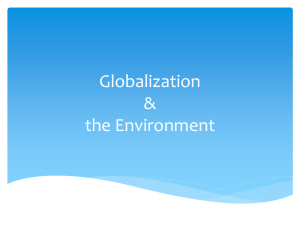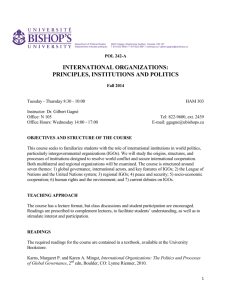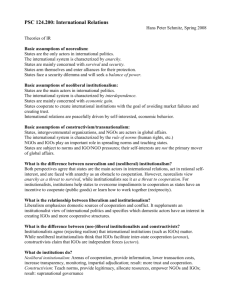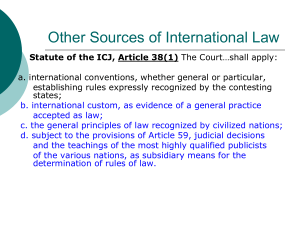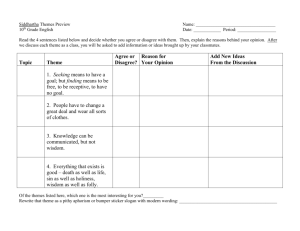Integrated Global Observing Strategy IGOS-P 11 Partnership
advertisement
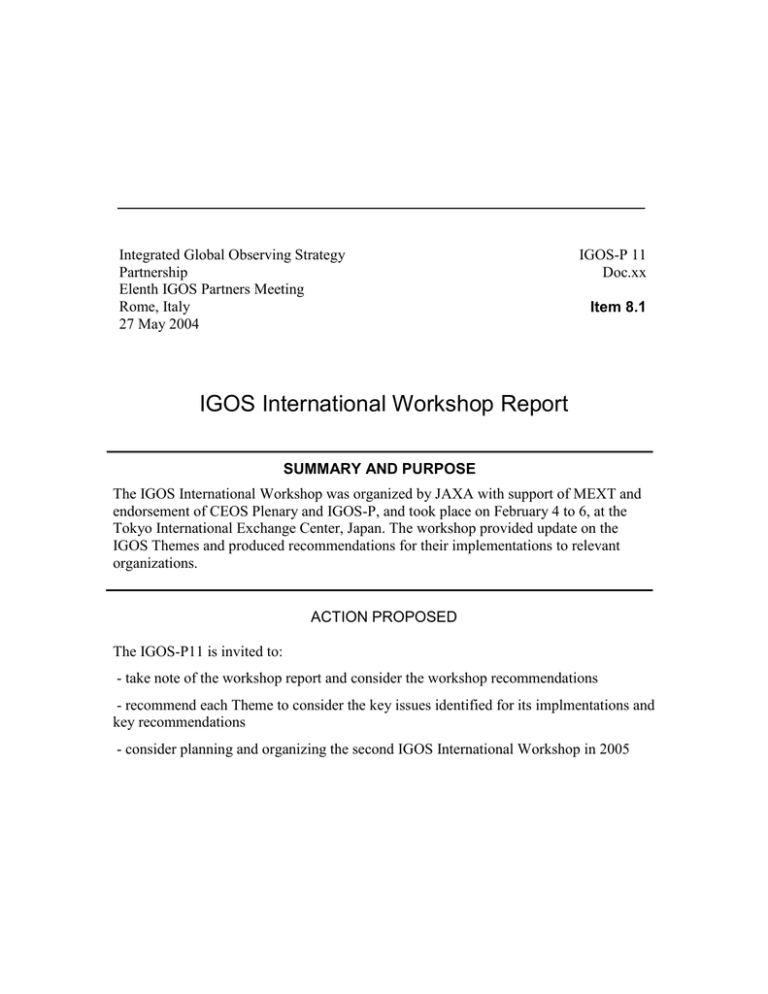
Integrated Global Observing Strategy Partnership Elenth IGOS Partners Meeting Rome, Italy 27 May 2004 IGOS-P 11 Doc.xx Item 8.1 IGOS International Workshop Report SUMMARY AND PURPOSE The IGOS International Workshop was organized by JAXA with support of MEXT and endorsement of CEOS Plenary and IGOS-P, and took place on February 4 to 6, at the Tokyo International Exchange Center, Japan. The workshop provided update on the IGOS Themes and produced recommendations for their implementations to relevant organizations. ACTION PROPOSED The IGOS-P11 is invited to: - take note of the workshop report and consider the workshop recommendations - recommend each Theme to consider the key issues identified for its implmentations and key recommendations - consider planning and organizing the second IGOS International Workshop in 2005 Report of the IGOS International Workshop Towards the implementation of the Integrated Global Observing Strategy (IGOS) Tokyo International Exchange Center “Plaza Heisei” 4th- 6th February 2004 V1.0 Report of the IGOS International Workshop Towards the implementation of the Integrated Global Observing Strategy (IGOS) Tokyo International Exchange Center “Plaza Heisei” 4th- 6th February 2004 V1.0 IGOS International Workshop/Rep/V0.1 4th-6th February 2004 1. WELCOME ADDRESS ................................................................................................................... 5 2. KEYNOTE PRESENTATION ON IGOS.......................................................................................... 5 3. REPORT ON EARTH OBSERVATION SUMMIT ........................................................................... 5 4. SPACE AGENCY RESPONSE TO IGOS ....................................................................................... 6 5. WMO’S GLOBAL OBSERVING SYSTEM ..................................................................................... 6 6. GLOBAL OCEAN OBSERVING SYSTEM ..................................................................................... 6 7. GLOBAL CLIMATE OBSERVING SYSTEM .................................................................................. 6 8. WORLD CLIMATE RESEARCH PROGRAMME ........................................................................... 7 9. INTERNATIONAL GEOSPHERE BIOSPHERE RESEARCH PROGRAMME .............................. 7 10. REPORT ON THE “WORKSHOP ON THE SATELLITE UTILIZATION FOR WATER CYCLE” .. 7 11. SIDE-MEETING OF THE EARTH OBSERVATION SUMMIT ........................................................ 7 12. REPORT OF SPLINTER SESSIONS ............................................................................................. 9 13. PANEL DISCUSSION “HOW CAN IGOS THEMES BEST BE DEVELOPED?” .......................... 9 14. CONCLUSIONS AND RECOMMENDATIONS OF THE WORKSHOP ....................................... 10 15. CLOSING REMARKS ................................................................................................................... 11 A IGOS INTERNATIONAL WORKSHOP RECOMMENDATIONS .................................................. 12 B SPLINTER SESSION REPORTS ................................................................................................. 13 Page 4 IGOS International Workshop/Rep/V0.1 4th-6th February 2004 Welcome address The Workshop Chairman, Prof. Toshihiro Ogawa (JAXA), welcomed the participants to the IGOS International Workshop. Mr. Kaoru Mamiya (JAXA Vice President) added his welcome to participants. He noted the efforts JAXA together with its partners has been making for the EO Summit, and expressed his wish for a productive meeting. Mr. Hiroshi Fukai (MEXT, Director of Summit Office) on behalf of Mr. Toichi Sakata (MEXT, Director General) gave his welcome remarks, referring to the international initiatives undertaken between the first Earth Summit in 1992 and the second Summit in Johannesburg in 2002, and expressed his hopes that the IGOS International Workshop would contribute to the efforts underway on the Earth Observation Summit Implementation Plan. Keynote presentation on IGOS Prof. Li Deren (NRSCC, CEOS/IGOS representative) gave the keynote presentation. He presented a brief history of IGOS and an outline of its process and Theme status. He noted that, as the Thematic coverage expands, IGOS would become have a more comprehensive scope and could be considered as addressing “Earth information science” or “Earth system science”. Then he gave an outline of the Ad hoc Group on Earth Observations (GEO), pointing out the opportunity for GEO and IGOS to co-operate via prototype projects within the strong policy framework of GEO. Report on Earth Observation Summit Mr. Hiroshi Fukai (MEXT) reported on the 1st Earth Observation Summit, held on 31st July 2003 in Washington DC, in which 23 international organizations and 34 states participated. The Summit had recognized the need for a comprehensive, coordinated and sustained global observing system. The Summit had also agreed on a Declaration, and a Framework to be prepared for the Tokyo ministerial meeting in spring 2004. A 10-year Implementation Plan is planned for presentation to the meeting to be held in Europe In February 2005. Mr Fukai gave an outline of the GEO organization, noting that the US, EC, Japan, and South Africa were Co-Chairs and that GEO comprised a number of Subgroups and a voluntary secretariat. He explained the key milestones for the Earth Observation Summit as follows: ・ 25th-27th February 2004 -- GEO-3, Cape Town ・ 22nd-23rd April 2004 -- GEO-4, Tokyo ・ 25th April 2004 -- 2nd EO Summit, Tokyo In conclusion, it was noted that MEXT is actively promoting discussion of these initiatives through domestic committees in Japan, including those of the Council for Science and Technology Policy. Mr. Fukai invited states to participate in the international dialog of the Earth Observation Summit. Page 5 IGOS International Workshop/Rep/V0.1 4th-6th February 2004 Space agency response to IGOS Dr. Yoji Furuhama (JAXA, CEOS/SIT Chair) reported on the activities of the CEOS Strategic Implementation Team (SIT), and on the CEOS inputs to IGOS on the various IGOS Themes and proposed Themes. He gave a brief outline of the roles of SIT, and then reported on the results of the 13th meeting of SIT which was held on 3rd Feb 2004 in Tokyo, and considered the key implementation issues and space agency commitments for each Theme. He highlighted the SIT 13 outcomes as follows: ・ SIT-13 saw excellent progress in IGOS Themes; ・ SIT-13 made clear commitments by space agencies for IGOS themes in mission planning, data, products and services; ・ SIT will continue to promote implementation and oversight of the IGOS space segment; ・ SIT invites international organizations to follow the same process. WMO’s Global Observing System Dr. Don Hinsman (WMO) reported on WMO’s Global Observing System (GOS). After giving a brief historical background of WMO and the United Nations, he presented the space-based component of the WMO Global Observing System - comprising geostationary and polar operational systems and R&D satellites. He also highlighted the WMO Global Atmosphere Watch (GAW) mission and motivation, stressing that global monitoring is a complex task requiring considerable co-ordination. Global Ocean Observing System Dr. Takashi Yoshida (JMA, GOOS representative) reported on the Global Ocean Observing System (GOOS). He presented an outline of the Joint Commission for Oceanography and Marine Meteorology (JCOMM), which addresses a range of satellite and in-situ observations. He also explained GODAE (Global Ocean Data Assimilation Experiment), which has the objective of demonstrating real-time, global ocean data assimilation for operational purposes; MERCATOR was highlighted as an example of a GODAE product. Dr Yoshida noted that many IOC member states are already involved in GOOS, although there is a need for improved regional alliances; he encouraged countries to take part in GOOS, stressing that continuous work on GOOS observation system improvements was crucial. Global Climate Observing System Dr. Alan Thomas (GCOS, Director) reported on the progress of GCOS as follows: 1992 WMO, IOC-UNESCO, UNEP and ICSU established GCOS for climate change research; The GCOS Second adequacy report was completed in April 2003, and was presented to UNFCCC SBSTA-18 and WMO Congress-XIV. “Global Observing Systems for Climate” was recognized in the UNFCCC/COP-9 Decision. The GCOS Implementation Plan will be open for review on the GCOS WWW site by end of April; the GCOS Co-operation Mechanism is based on voluntary international funding and co-ordination of global observing systems for climate - especially for the least developed counties and SIDS. The initial meeting of the Cooperation Board will be in the UK in May 2004.COP-9 welcomed the establishment of the GCOS Co-operation Mechanism; Page 6 IGOS International Workshop/Rep/V0.1 4th-6th February 2004 IGOS Themes are recognised as a potential source of many of the climate products specified in the the GCOS Second Adequacy Report. World Climate Research Programme Dr. Rick Lawford (GEWEX International Program Office Director) gave a report entitled “Why WCRP is a partner in IGOS-P”. He introduced the WCRP domains, including both land and ocean, covered by programmes such as GEWEX, SPARC, and CLIC. He noted that WCRP is a major user of Earth observation satellite data, and that WCRP has promoted new methods for better analysing satellite data for climate studies. He presented the Coordinated Enhanced Observing Period (CEOP) as an initial IGOS project, and explained the planned COPE project. He noted that WCRP will continue to be an active partner for IGOS-P and had high hopes for tangible benefits arising from this partnership. International Geosphere Biosphere Research Programme Dr. Pep Canadell (CSIRO) reported on IGBP, its role and objective, products and future prospects. He presented the ocean-atmosphere IGAC as a long-term project looking at the atmosphere, and the new initiative ‘ILEPS’ for land atmosphere. He also referred to the global land project and noted the need for more interdisciplinary studies. He reported on the Global Carbon Project (GCP), on which IGBP is the lead agency, and explained the importance of integration of research, observations and assessment. He highlighted the relationship of IGBP to the IGOS Themes and their contributions to IGCO, IGACO, Coastal Zone/ Coral Reef, Water Cycle, Proposed Terrestrial/Land Theme and the Ocean Theme. Report on the “Workshop on the Satellite Utilization for Water Cycle” Prof. Kenji Nakamura (Nagoya University) gave a report on the ‘Workshop on Satellite Utilization for the Water Cycle’ held on 3rd-4th February 2004. He noted that the workshop was well attended especially by many Asian participants. Topics referred to were: ・ Now-casting/Short-term prediction, Weather forecast, flood (flash/slow) forecast, forest fire; ・ Long-term ENSO, drought, snow melting, glacier, permafrost He reported that short-term monitoring was emphasized rather than long-term observations. The Global Precipitation Measurement mission (GPM) was introduced as a valuable future satellite resource for information on the water cycle. Prof. Nakamura pointed out that, whilst utilization for water resource management, was only partly addressed at the workshop, perhaps the next step for the discussion in the community would be ‘implementation’ – how to coordinate the framework, such as possible partnerships for satellite data utilization. Side-meeting of the Earth Observation Summit After the Plenary session, there was a side-meeting on the Earth Observation Summit chaired by Mr. Hiroshi Fukai (MEXT, Director of Summit Office). He presented a plan for the Summit to be held on April 25, 2005 and invited states to participate in the Summit. Page 7 IGOS International Workshop/Rep/V0.1 4th-6th February 2004 Chu Ishida reported recommendations agreed by the Asia-Pacific Regional Space Agency Forum (APRSAF) held in Chiang-Mai, Thailand on January 14th-16th, 2004, to enhance APRSAF activities such as establishing data archive systems, promoting data applications, and conducting capacity building in accordance with the framework of the Earth Observation Summit and GEO. Page 8 IGOS International Workshop/Rep/V0.1 4th-6th February 2004 Report of splinter sessions The outcomes of each of the Workshop splinter sessions were reported by the session chairs: IGOS Themes Ocean Theme (reported by Dr. Eric Lindstrom (NASA)) Global Carbon Observation Theme (reported by Dr. Pep Canadell (CSIRO)) Global Water Cycle Theme (reported by Dr. Rick Lawford (WCRP)) Atmospheric Chemistry Theme (reported by Prof. Toshihiro Ogawa (JAXA)) Geohazards Theme (reported by Dr. Stuart Marsh (BGS)) Coastal Theme (reported by Dr. Paul DiGiacomo (JPL)) Cross-cutting issues Data Integration (reported by Prof. Tohsio Koike (Univ. of Tokyo)) Capacity Building (reported by Prof. Shunji Murai (Univ. of Tokyo/Keio Univ.)) These reports, including recommendations, are attached as an Annex (B) to this document. Panel Discussion “How can IGOS Themes best be developed?” The Panel moderator Prof. Shimoda (Tokai Univ./JAXA) suggested that the panel focus on two main topics: (1) “What are the key issues for the implementation of the IGOS Themes, and how can they be solved?” (2) “How will IGOS be able to contribute to the Earth Observation Summit – and what will Earth observation be like in 10 years?” Dr. Lindstrom (NASA) noted the importance of credible political/economic structures to deploy and maintain in-situ observations over long periods, as well as the need for capacity-building and a sound implementation strategy. Dr. Lawford (WCRP) pointed out that IGOS, especially the in-situ component, does not have much visibility in the science community. He also indicated that more dialogue and interaction on the overlap of theme components were needed. He pointed out the issue of raising adequate budget support for the Themes. IGOS-P should present its theme activities clearly and compellingly to GEO. He indicated thet the future of Earth observation depended on the extent of commitment from space agencies, on in-situ community co-operation, and on political support. Dr. Marsh (BGS) referred to the need for co-ordination of the ground-based aspects and networks, pointing out that the in-situ community has ‘no door like CEOS to knock on’. He suggested the importance of an implementation mechanism, and mentioned a potential future “World Geo-hazards Organization”. Prof. Paul Mason (GCOS), steering committee chair suggested that in order to take forward implementation, there is a need to identify issues that will lead to a product that people will use, and that will lead to the will to see those products to continue and to encourage users to pay for the products – Page 9 IGOS International Workshop/Rep/V0.1 4th-6th February 2004 noting that policy makers in GEO will want to know the outputs planned and what price they will need to pay. Prof. Mason expressed his expectations that in the coming ten years, remote sensing will play a much bigger role and stressed that Themes must ensure that the benefits to society are realised. Dr. Furuhama (JAXA) suggested the need to assess socio-economic impact, and the need to involve related organizations - not only from the science point of view, but also from the socio-economic stance. He also stressed the importance of government commitment for implementation, both in the space and in-situ segments. As to how IGOS will contribute to the Earth Observation Summit, he noted that the IGOS process is very effective ,and suggested that: 1) present IGOS themes are not comprehensive in their coverage (Land biodiversity etc must be added with the participation of new organizations); 2) the IGOS process is a mechanism that organizations interested in implementing themes operate on a best-efforts and no exchange of fund basis. He concluded that gaining direct government support and commitment is a key issue. Dr. Hinsman (WMO) expressed that whilst he is very optimistic about what Earth observation will look like in 10 years, it must be recognised that some in-situ networks are currently in urgent need of repair. He noted that Earth observation information is now receiving unprecedented visibility - GEO is an opportunity to define policies for the integration of Earth observation capabilities; IGOS-P, which has identified needs, and assembled communities for dialogue, should be a major input to the GEO process. He concluded that the future for both IGOS-P and for Earth observation is very bright. Dr. DiGiacomo (NASA/JPL) indicated the importance of the Theme framework and the need to secure buy-in from donors and stakeholders - looking at the benefits and utility of the Themes. As to how IGOS will contribute to the Earth Observation Summit, he noted that IGOS is a stepwise process into a which tremendous amount of intellectual activity has been invested, and is a valuable framework upon which to build the GEO framework. As to what will Earth Observation look like in 10 years, he indicated that the ongoing integration efforts are likely to break down boundaries and provide better access and transparency of information - comparable to the development of the Internet. There was a comment from the floor on the balance between space and ground segment, suggesting that greater integration of effort was necessary. It was agreed by the panel that data integration is an essential issue, and that in some Themes – such as the Ocean Theme - it has been addressed, but less so in others. A further opinion from the floor suggested that IGOS-P must have the real end-users involved: local authorities and civil agencies. The panel recognized the challenge of developing such dialogue with end-users - noting that in some cases end-users are extensively involved, or example in the case of the International Charter on Disasters. Prof. Shimoda thanked all the participants and the panel for the active discussion. Dr. Lindstrom thanked the moderator and the hospitality of the host. Conclusions and recommendations of the Workshop In addition to the recommendations developed by the splinter sessions specific to each of the Themes or cross-cutting issues, Prof. Toshihiro Ogawa (JAXA) proposed a series of draft recommendations to capture the spirit of the discussions arising during the Workshop. With a number of revisions proposed from the floor, the Workshop agreed on the recommendations attached in Annex A. Page 10 IGOS International Workshop/Rep/V0.1 4th-6th February 2004 Closing Remarks Dr. Furuhama (JAXA) gave the closing remarks. Noting that this was the first meeting to address all IGOS Themes in such a manner, he stressed the importance of the visibility of IGOS, and the need to strengthen the linkagse to the GEO and Earth Observation Summit processes. He expressed his wish for the success of the coming Earth Observation Summit in Tokyo in April, and closed the Workshop by thanking all participants for their contributions. Acknowledgement The IGOS International Workshop was funded by MEXT's JFY-2003 “Special Co-ordination Fund for Promoting Science and Technology." Page 11 IGOS International Workshop/Rep/V0.1 4th-6th February 2004 A IGOS International Workshop Recommendations In the closing Plenary session of the Workshop, participants reviewed and discussed a number of draft recommendations proposed by the Chair to reflect the discussions of the preceding sessions. After some modifications, the following nine recommendations were finalised: 1. The workshop recognized that a number of Themes are now mature or nearing approval. Oceans, Water Cycle, Geo-hazards, Carbon, Atmospheric Chemistry, and Coastal Themes may all be approved by June 2004. It is recommended that these Themes serve as a major input for implementation of the first phase of GEO. 2. IGOS-P has demonstrated the importance of a step-wise approach to implementation of integrated global observations. It is recommended that GEO adopt the same approach, including existing IGOS Themes where appropriate. 3. The workshop noted that the Earth observation community is aware of the value of the GEO process in securing necessary political support for all elements of the IGOS Themes – both satellite and in-situ observing systems, modeling, communications etc. Further steps should be taken to make the necessary linkages between the two frameworks – including incorporation of the IGOS Themes into the GEO Implementation Plan. 4. GEO should urge its member governments and international organizations to facilitate access to the those data-sets of greatest societal value and to promote open exchange and distribution of such data. 5. Greater emphasis should be given to ‘capacity building’ in the definition and implementation of IGOS Themes. 6. The workshop recognized a common need of many of the IGOS Themes to better define their implementation plans, including: a clear statement of the institutional framework; responsibilities and leadership; main data products and services; and user groups. 7. IGOS Themes need to ensure that their quoted requirements represent the needs of the proposed user communities. It is recommended that each Theme consider one or more technical workshops to define their implementation plans and to achieve community ownership. 8. The success of the workshop demonstrated the need for IGOS-P to further develop its public profile. Suitable profile-raising outreach activities should be undertaken. 9. For each IGOS-P Theme, the key issues identified in the workshop splinter sessions should be considered for the further development, revision or implementation of the Theme report. Page 12 IGOS International Workshop/Rep/V0.1 4th-6th February 2004 B Splinter session reports B.1 Ocean Theme - Dr. Eric Lindstrom (NASA) Prof. Shiro Imawaki (Univ. of Kyushu) Session highlights A number of presentations on the space component were featured: ocean topography, ocean vector winds, sea surface temperature, sea ice concentration, and gravity field. On the in-situ side, featured presentations included those on GOOS, ARGO and CLIVAR. A number of Japanese agencies reported on their activities, including: Japan Meteorological Agency, the Hydrographic and Oceanographic Department, Fisheries Research Agency, and JAMSTEC. Several synthesis activities for the Ocean Theme were also discussed: - Data services, models, products, and applications (GOOS and IODE); - Data assimilation and ocean prediction (GODAE). Key recommendations 1. Re-organization of the Ocean Theme report: First level by environmental parameters Second level by organization o Continuity; o Knowledge o Implementation issues 2. 3. 4. 5. Need to boost in-situ systems content level of detail; Need to include sections on interface with Coastal, Carbon, and Water themes; Need to recognize relationship with solid earth systems and geodesy. Need to recognize issue of human capital and capacity building for success of observing systems; Need to show more examples and successes in data/products services. Success of ocean data systems should be highlighted. Feedback between observations and products. 6. Ocean Theme next steps: - a rolling review in 2004; co-ordination with Carbon and Coastal themes; addressing stubborn continuity challenges; identifying new knowledge challenges; publishing a new Ocean Theme report. A review team will be assembled to update the status of the Theme, write a new report and arrange for review, and publish and promote the document. Page 13 IGOS International Workshop/Rep/V0.1 4th-6th February 2004 B.2 Global Carbon Observation Theme - Dr. Pep Canadell (CSIRO) Dr. Gen Inoue (NIES) Session highlights Overviews of IGCO and GCP presented. IGCO and GCP are encouraged to work in a coordinated manner; The current status of flux (Terrestrial and Ocean) and atmospheric observation networks were reported with specific recommendations on expanding the number of sites (eg Tropical Asia, Southern Ocean); Capacity building was recommended in less developed countries; Numerous projects were presented as a contribution to the IGCO implementation, eg: 1.1 GOSAT and OCO will contribute to the IGCO implementation; 1.2 High-resolution global land cover using ALOS will contribute to Kyoto Protocol (IGCO implementation); 1.3 Observing cruisers and Ships Of Opportunity Program for pCO2 measurements. Key issues identified for Theme implementation Data continuity Data access Systematic observation Coordination of observations Implementation framework Key recommendations High-resolution observations are a common requirement for carbon in remote sensing and in-situ measurement (eg.100m resolution for global land cover). Data continuity and consistency are important in remote sensing and in-situ measurement - not just R &D or innovation. Institutional constraints should be solved to provide systematic and sustainable measurement. CONCERTED EFFORT IS REQUIRED IN MEASURING SOCIO-ECONOMIC INDICES USING REMOTE SENSING AND IN-SITU PLATFORMS. SUPPORT FOR DEVELOPMENT OF A CROSS-CUTTING THEME ON SOCIO-ECONOMICS UNDER IGOS-P. There is need for sustained effort on capacity building to develop a global observing system in less developed countries. Promote and encourage national governments to exchange and distribute data (eg meteorological, global re-analyzed data). Page 14 IGOS International Workshop/Rep/V0.1 4th-6th February 2004 B.3 Global Water Cycle Theme - Dr. Rick Lawford (WCRP) Prof. Kenji Nakamura (Univ. of Nagoya) Session highlights A number of opportunities for the Theme were recognised: data assimilation capabilities are leading to much more effective use of data in the prediction process; WMO commitment to developing a space component for its Global Observing System; space agencies are bringing exciting new systems on-line that could advance GWC science; .there is a growing awareness of extremes, climate change and the consequences of climate change for extremes; through CEOP, we have developed a base of experience for moving forward with more ambitious data integration plans. And key challenges were discussed: the scale at which many water-related activities take place is very different from the scale of available information; the global water cycle involves “small and subtle fluxes” moving between much larger reservoirs; this poses a major measurement challenge; national meteorological networks, hydrologic networks and water advisory services are often very independent - making integration more difficult. Key issues identified for Theme implementation 1. there is a need to develop a broad base of support (experts, resources) to implement the theme; 2. long-term commitments by space agencies are needed to ensure that critical satellite data are available during the lifetime of the IGWCO implementation plan (eg space-borne radar on TRMM); 3. there is a sense in some developing countries that they don’t have adequate opportunity to make maximum use of satellite data and to benefit from IGOS themes such as IGWCO; 4. steps are needed to foster improved in-situ networks for relevant water cycle variables and free and open exchange of in-situ data on a world-wide basis; 5. a paradigm for interacting with GEO that will make it easier for IGWCO to display its interests, issues and activities within this framework is needed. Key recommendations 1. IGWCO should advance its plans for initiatives related to: CEOP integrated products; GWSP data requirements definition; an integrated precipitation product; indicators; it should also consider initiatives in the areas of downscaling; 2. GEO and IGOS-P should place more attention on issues related to the integration of physical and human dimension data; Page 15 IGOS International Workshop/Rep/V0.1 4th-6th February 2004 3. IGOS-P (and IGWCO) should explore options for capacity building through the WMO, UNESCO and the dialogue on water and climate frameworks; 4. IGWCO should sharpen its statement of needs for satellite and in-situ data and make these known to GEO (for policy support), to CEOS (for satellite data) and to WMO (for in-situ data) to ensure actions are taken to address these needs; 5. IGWCO should co-ordinate some regional workshops as part of its efforts to define the needs for GWC data and as a first step in its contribution to training and capacity-building; 6. IGWCO should work with GCOS and WMO to develop a strategy for encouraging the more effective transfer of precipitation and runoff data to WCRP data centers, and to promote free data exchange more generally. Page 16 IGOS International Workshop/Rep/V0.1 4th-6th February 2004 B.4 Atmospheric Chemistry Theme - Prof. Toshihiro Ogawa (JAXA) Dr. Stephen Briggs (ESA) Session highlights Review of IGACO Theme Report Review of Japanese components of IGACO GAW ground-based systematic observations (JMA) Systematic observations aboard commercial aircraft (JAL) NDSC graund-based systematic observations (NIES) Air quality/aerosol observation network in Taiwan Research/demonstration phase observations Key issues identified for Theme implementation 1. Gaps between our goal and the present status in Japan/Asia • Ground-based observations • Aircraft observations • Satellite observations • Data management – Quality control – Data archive • Numerical models – Chemistry climate model – Inverse model 2. How to develop research/demonstration type observations to routine/systematic observations? Key recommendations Need for: Coordinated monitoring network of satellite/balloon/aircraft/ground-based measurements; especially focusing on realizing the following: Coordination among in-situ observations of several agencies ( JMA/GAW, NIES rural stations, NIES/NDSC, etc); Satellite monitoring system for air quality in Asia, including precursor gases of GHG inventory/climate change; Page 17 IGOS International Workshop/Rep/V0.1 4th-6th February 2004 Maintaining the mount-top station of Mt. Fuji; Additional ground-based column measurements ( CO, CO2 by FTIR, NO2 & SO2 by DOAZ); Campaign type measurements (in addition to long-term comprehensive measurements) for validating satellite data and model results. B.5 Geo-hazards Theme - Dr. Stuart Marsh (BGS) Dr. Hiroshi Ohkura (NIED) Session highlights 10 presentations were provided in this session. One was the introduction of the Geo-hazard IGOS Theme report, and the others covered the earthquake, volcanoes, landslides, and operational systems. Plans for the Geo-hazard Theme implementation were explained, with a framework based on UNESCO’s GARS programme, a Theme bureau funded by ESA, and five working groups. Key space segment requirements were reviewed: - baseline global topography: this data us required for all types of geo-hazards and is used in mapping, modelling and visualization; a global, consistent, high-resolution dataset is required; - baseline geo-science mapping: ASTER & Landsat continuity are key issues; - ground displacement: the need for future continuity in C-band and L-band sensors for use in INSAR was explained; C-Band INSAR was noted as being near “operational” in urban/arid settings – thanks to the continuity provided by the ERS/ENVISAT series; - L-band: continuity is still vital; Improvements in in-situ data-seismic networks – such as GPS networks – are also crucial. The need for international data-sharing of in-situ data was highlighted. The high price of satellite data, as being prohibitively expensive for widespread application was also noted. Key recommendations Gravity data (atmospheric data) is necessary. This data is related to both the atmospheric chemistry and Water Cycle themes. Page 18 IGOS International Workshop/Rep/V0.1 4th-6th February 2004 B.6 Coastal Theme - Dr. Paul DiGiacomo (JPL) Dr. Shinichi Iwasaki (NIED) Key issues identified for Theme implementation 1. Need for improved data access, integration, and distribution; 2. Need to develop/refine models, satellite algorithms and assimilation skill; 3. Robust in situ data collection and continuity is critical, including for cal/val; 4. Ocean & Coastal Themes will benefit from coordinated implementation; 5. Need to support capacity building (training, collection, and decision-support); 6. Require improved temporal, spectral, & spatial coverage of coastal zones. Key recommendations IGOS-P: Need to incorporate social sciences throughout process; IGOS-P: Beneficial to develop an IGOS Land Theme in near-future; IGOS-P/GEO: Encourage increased interactions between IGOS themes; GEO: Improved national coastal observing capabilities should be a priority; CEOS: Develop platforms/sensors that will address coastal observing gaps. Page 19 IGOS International Workshop/Rep/V0.1 4th-6th February 2004 B.7 Data Integration - Prof. Toshio Koike (Univ. of Tokyo) Key issues identified for Theme implementation Data policies 1.4 1.5 1.6 1.7 1.8 1.9 coordination/harmonization by relevant international organizations data accessibility data timeliness data provider's privilege for R&D acknowledgement metadata (documentation on the data) Standards, practices and calibration 1.10 standard format or conversion function based on data description 1.11 quality control 1.12 real time or delayed mode Transformation of measurements into information o o o o combination with many other data sources: natural science – socio-economic too voluminous and heterogeneous prediction needs: Information sharing worldwide Key recommendations To IGOS-P or related entities: Establish a Data Integration Function, distributed/centerized, in each Theme and encourage collaboration among Themes; Page 20 IGOS International Workshop/Rep/V0.1 4th-6th February 2004 Promote co-operation between the IGOS Themes and Global Mapping for strengthening the Theme impact on socio-economical aspects; Promote collaboration among research communities and operational organizations for establishment of sustained Data Integration systems. To GEO, sponsoring bodies etc: Develop a ten year implementation plan for Data Integration by considering perspectives on computing power and data amount; Emphasise the combination of in-situ data/satellite data /model output with socio-economic data for contributions to sound decision-making; Promote collaboration among research communities and operational organisations for establishment of sustained Data Integration systems. B.8 Capacity Building - Prof. Shunji Murai (Univ. of Tokyo/Keio Univ.) Session highlights The main topics of discussion were: data sharing; the SEASON project (Tokyo Univ) for sharing MODIS and AVHRR data in the Asian region free of charge, including software transfer, workshops and research collaboration; the Global Rainfall Forest & Boreal Forest project (JERS-1) mosaic data-sharing by JAXA, JPL, and JRC; Digital Asia: participatory GIS assisting national geo-spatial data infrastructure; JAXA capacity-building activities at AIT: RS and GIS training and seminars; e-learning on RS and GIS (sponsored by JICA) Key issues identified for Theme implementation cost of data; real-application is very limited Key recommendations To develop a comprehensive capacity-building approach; To provide open archive data for potential users; Page 21 IGOS International Workshop/Rep/V0.1 4th-6th February 2004 To build a regional and local experts/resources/application network to achieve positive participation in technology transfer; To share data free of charge; To share information on capacity-building activities to avoid duplication; Capacity-building should be promoted to strengthen the IGOS projects, International and regional cooperation on capacity-building should be established based on mutual benefit to developed and developing countries; Distance education or e-learning on integrated global observing systems - together with free access to global data sets should be developed; International and regional networks with respect to capacity-building should be established jointly with other international and regional organizations. Page 22
